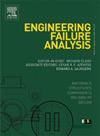PMTMSC成形过程等效试验中PI绝缘膜的损伤失效及映射模型
IF 4.4
2区 工程技术
Q1 ENGINEERING, MECHANICAL
引用次数: 0
摘要
电磁线上的聚酰亚胺(PI)薄膜是电子器件的重要绝缘材料,但成型过程中的机械载荷会对聚酰亚胺薄膜造成损伤。本文通过成形过程的等效实验,研究了PI保温膜在不同应力集中区的损伤规律,并分析了成形过程和裂纹扩展的演化规律。研究方法包括:基于弯曲加载断裂模拟方法分析应力集中区和裂纹起裂规律,基于断裂力学分析方法计算应力和裂纹长度,基于扫描电镜(SEM)测试方法表征裂纹扩展演化规律。建立等效试样与成形线圈之间的映射模型,并将其应用于中铁高速列车(CR450)永磁牵引电机定子线圈(PMTMSC)的成形过程中,将等效试样的损伤规律与实际工程联系起来。结果表明,等效样品与线圈原型的残余应力误差为8.6%。等效试验中弯曲挠度达到38 mm时,产生2.8 μm裂纹,绝缘电阻试验通过后存在失效风险。优化后成型线圈挠度小于64mm,可避免绝缘失效。为电磁线材电气材料的制造成形工艺优化及线圈结构设计提供实验依据。本文章由计算机程序翻译,如有差异,请以英文原文为准。

Damage failure and mapping model of PI insulation film in equivalent test of PMTMSC forming process
The polyimide (PI) film on the electromagnetic wire is an important insulation material for electronic devices, but the mechanical load during the forming process can pose a risk of damage to the polyimide film. This article studies the damage law of PI insulation film in different stress concentration areas through equivalent experiments of the forming process, and analyses the evolution law of the forming process and crack propagation. The research methods include: analysing the stress concentration area and crack initiation law based on bending loading fracture simulation method, calculating the stress and crack length based on fracture mechanics analysis method, and characterizing the crack propagation evolution law based on scanning electron microscopy (SEM) test method. Build a mapping model between the equivalent sample and the formed coil, and apply it to the forming process of the permanent magnet traction motor stator coil (PMTMSC) of China Railway High speed Train (CR450), linking the damage law of the equivalent sample to practical engineering. The results indicate that the error in residual stress between the equivalent sample and the coil prototype is 8.6 %. When the bending deflection reaches 38 mm in the equivalent test, there is a 2.8 μm crack initiation, which poses a risk of failure after passing the insulation resistance test. After optimization, the deflection of the formed coil is less than 64 mm, which can avoid insulation failure. Provide experimental basis for optimizing manufacturing and forming processes and coil structure design of electromagnetic wire electrical materials.
求助全文
通过发布文献求助,成功后即可免费获取论文全文。
去求助
来源期刊

Engineering Failure Analysis
工程技术-材料科学:表征与测试
CiteScore
7.70
自引率
20.00%
发文量
956
审稿时长
47 days
期刊介绍:
Engineering Failure Analysis publishes research papers describing the analysis of engineering failures and related studies.
Papers relating to the structure, properties and behaviour of engineering materials are encouraged, particularly those which also involve the detailed application of materials parameters to problems in engineering structures, components and design. In addition to the area of materials engineering, the interacting fields of mechanical, manufacturing, aeronautical, civil, chemical, corrosion and design engineering are considered relevant. Activity should be directed at analysing engineering failures and carrying out research to help reduce the incidences of failures and to extend the operating horizons of engineering materials.
Emphasis is placed on the mechanical properties of materials and their behaviour when influenced by structure, process and environment. Metallic, polymeric, ceramic and natural materials are all included and the application of these materials to real engineering situations should be emphasised. The use of a case-study based approach is also encouraged.
Engineering Failure Analysis provides essential reference material and critical feedback into the design process thereby contributing to the prevention of engineering failures in the future. All submissions will be subject to peer review from leading experts in the field.
 求助内容:
求助内容: 应助结果提醒方式:
应助结果提醒方式:


